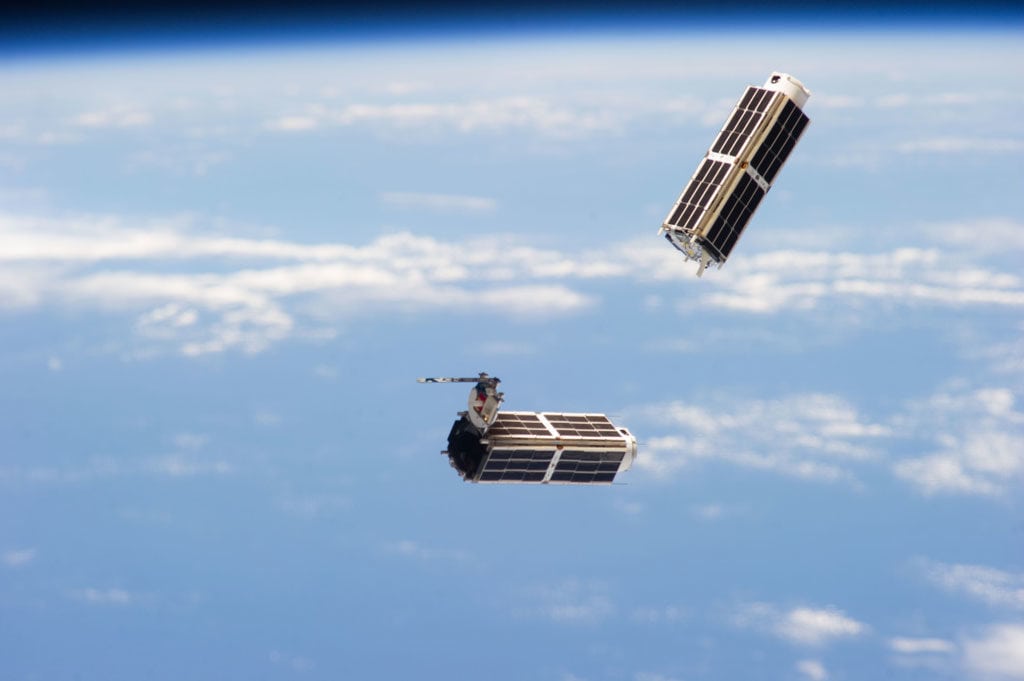Latest News

Smallsats deployed from ISS. Photo: NASA
An increase in U.S. government and military spending on launch services, combined with a sharp spike in small satellite activity and the emergence of commercial space travel and tourism will create a total space economy worth approximately $350 billion, according to Sheila Kahyaoglu, satellite equity analyst at Jefferies, and author of a recent report, “The Evolving Space Launch Market: Ready for Take-Off.” The commercial market accounts for about 75 percent of that total market value ($258.7 billion).
In the report, Kahyaoglu wrote that demand for launch vehicles are being driven by a number of sources, including commercial launch customers and domestic and international governments. “In total, the space economy is estimated to be roughly $345 billion. Within the broader space economy, launch vehicles help deliver satellites that support services such as television, satellite radio, and broadband services,” she said. “Approximately 75 percent of the space economy is commercial, with the remainder from government budgets. Within the sub-segment of the economy an estimated $12 billion of revenue is from launch services, including government.”
Kahyaoglu added that secondary growth will driven by a broader shift to utilizing smaller satellites for lower orbits and the allure of space travel, which has some crossover with the launch market. “We see the most opportunity for Northrop Grumman (LV content 3 percent of sales, 20 percent space), both as a merchant supplier and fully integrated manufacturer of launch vehicle solutions,” she wrote.
Northrop Grumman (NGC) faces an uphill battle given incumbency, but has a long history and track record of success for its rockets. “The company also has a solid pitch as a vertically integrated company, being a supplier of avionics, solid rocket motors and composites,” Kahyaoglu added. “In our view Antares has been somewhat of a disappointment. There were expectations to get launches outside of NASA, which has not materialized. The natural extension is OmegA, with initial funding from the Air Force. NGC’s Omega rocket is expected to deliver 5,250 to 7,800 kgs to Geostationary Equatorial Orbit (GEO). The program also uses current proven technology and draws upon NGC’s prior launches. First flight is expected in 2021 with operational flights beginning in 2022.”
Launch costs can be broad, from several hundreds of thousands of dollars to lift a small satellite into space to the most exquisite satellites that could be launched only on a Delta IV. “This is mostly a government market, where launch costs could reach $200-400 million per launch when accounting for add ons and overhead,” said Kahyaoglu. “In comparison, the cost for the largest human space launchers can be well in excess of $1 billion per flight.”
Kahyaoglu hails SpaceX as the “biggest disruptor” in the industry, and says the company now has a solid foundation, with flagship programs from NASA (CRS and Commercial Crew) coupled with Air Force launches which have provided the benefit of scale. She believes the Falcon 9 has laid a solid foundation with the Falcon Heavy the next big step. She says the company’s aspirations seem to be evolving. “The company is working on Starship and Super Heavy (previously BFR) with aspirations for the Moon. The rocket is planned to take a private passenger for a flight around the moon in 2023,” she said. “The new rocket is expected to be a fully reusable transportation system for all orbits, the Moon and Mars and replace all of the company’s current launch vehicles. Missions could include satellite delivery, space station missions and interplanetary transport.”
When it comes to Arianespace, Kahyaoglu spoke of the prospects for Ariane 6, which is expected to come in two variants, the A62 and heavier variant, the A64. “Ariane 6 is expected to have a base price of $85 million, with the heavier variant (11,500 to GTO) expected to cost about $102 million,” she says. “The program is supported by the government. European public entities have purchased several missions including two to launch Galileo navigation satellites and one for a French CSO-3 military imaging satellites. In September 2018, Eutelsat signed a contract for five satellite launches on Ariane 6 through 2027. The award was the first commercial contract. More recently France’s independent state auditor raised concerns about the viability of the Ariane 6 launchers, believing it was too cautious to compete with growing competition between the likes of SpaceX.”
There are clearly a number of new players in the market, and competition between them all is likely to be intense. Kahyaoglu described the commercial market as “choppy” for all of the players. “The commercial launch market tends to be more competitive and uneven. The purpose is to monitor earth’s service and provide connectivity,” she said. “Orders for GEO satellites peaked at 26 units in 2014 with five orders in 2018. The market could return to the normalized mid-teens order rate ($125 million a unit equates to an annual market size of about $2 billion), but uncertainty from small satellite constellations and capacity from high-throughput satellites has put a pause on the market. Order to launch is typically 18 to 24 months.”
Get the latest Via Satellite news!
Subscribe Now